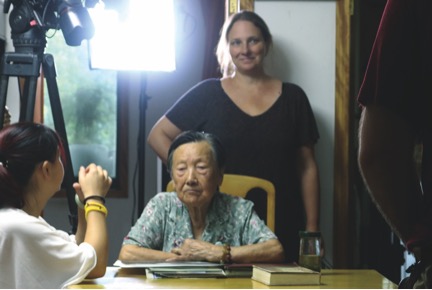What ‘The Girl and The Picture’ is really about

EDITOR’S NOTE: Vanessa Roth is the director of ‘The Girl and The Picture,’ a documentary about a survivor of the 1937 Nanjing Massacre who shares her memory of the trauma with her granddaughter and great-grandson. The film has screened at four festivals and won five awards. Here Vanessa, an Academy Award-winning filmmaker, shares her thoughts on what creating the film has meant to her.
The Girl and The Picture is about bearing witness. It is about giving voice to the human experience and it is about storytelling so that the past is not forgotten.
While The Girl and The Picture focuses on the story and voice of one of the last remaining survivors of the Nanjing Massacre of 1937 -- which in and of itself is a gift to us, as generations and a world that know little to nothing of this massacre – it is also a project that I saw as a chance to excavate forms of storytelling itself – and look at different ways we preserve legacy and memory and process loss and survival.
When I came to the project, I knew that Madame Xia had been interviewed many times about her horrific experience the day that her entire family was murdered and she was only 8 years old. These interviews for news and films across the world were vital to providing personal testimony to an event that has less than 100 survivors to recount it, and gave a human face to these historic events. Her story is also part of the profoundly moving The Memorial Hall of the Victims in Nanjing Massacre by Japanese Invaders as well as a pioneering and extraordinary project by the Shoah Foundation – called Dimensions in Testimony – which uses groundbreaking natural language software to allow audiences to interact with the recorded image of a genocide survivor, who responds to questions in real time, powered by complex algorithms providing realistic conversation. These are incredible forms of storytelling – of bearing witness to human experience so that the past is not forgotten.
So her personal story itself has been well documented. In fact, her story was documented for the first time two weeks after the massacre when she was visited by an American Missionary in China, John Magee who had been so horrified by the atrocities he witnessed that he turned his 16 mm home movie camera into a tool to record what he saw and to show the world what had happened in Nanjing. He then sent those films, including the images of 8-year-old Xia Shuqin to Life Magazine, to the US film division and to governments around the world as well as showed them at the first international war tribunal for crimes against humanity. These too, are all forms of storytelling – of bearing witness to human experience so that the past is not forgotten.
With all that Madame Xia has done to make her existence, her loss and her survival known, I saw a void in the storytelling – which was in the passing down of personal and family history with her own children, grandchildren and great grandchildren. And this, I believe is one of the most important and overlooked forms of keeping history present and human, and is the way that we can most immediately feel connected to the past and each other. Because after all, our ancestors’ stories are our stories.
And so this is the lens with which I approached this film. While the grandson of John Magee comes to Nanjing to trace the footsteps of his grandfather so that he can bear witness to his family story, our film glimpses the sweet and special relationship between grandparents and grandchildren as Madame Xia spends time with her granddaughter Yuan and 7-year-old great grandson Yuhan.
She tells them her story of their lost ancestors and her life and the hardships she lived through before becoming their grandmother. And then, in turn, to preserve the story of her grandmother for future generations of the Xia family, Yuan bears witness herself, by writing the story down as a letter, so that none of this personal family history is ever forgotten.
In the end, my hope is that this film is seen as a symbol of the of power of passing down family history to bridge generations and preserving our shared history in order to know our past and ourselves better and to never forget.
Like this article? Get our e-newsletter.
Be the first to learn about new articles and personal stories like the one you've just read.